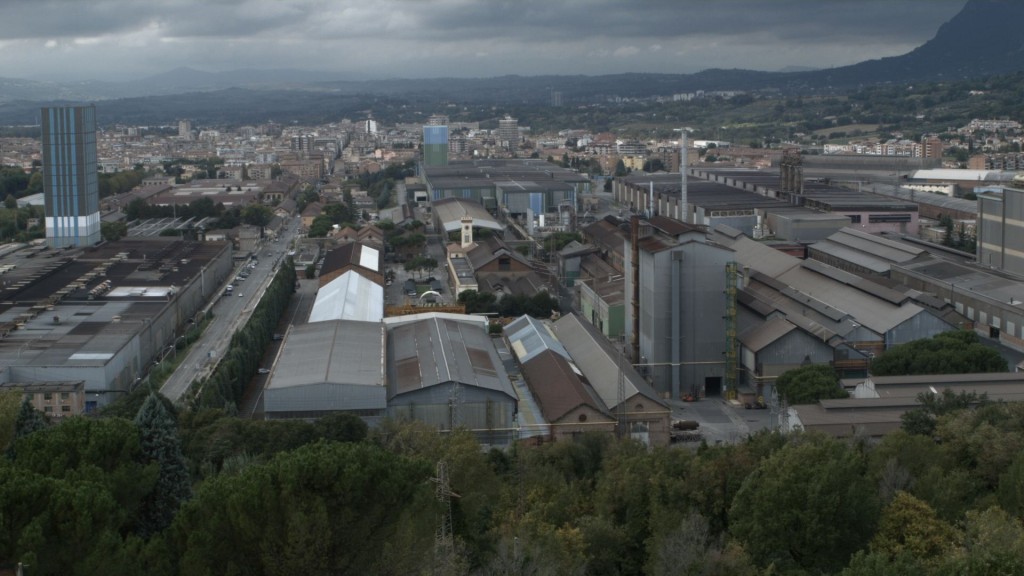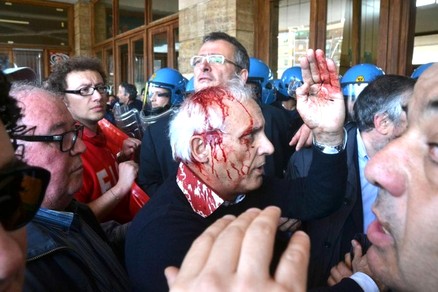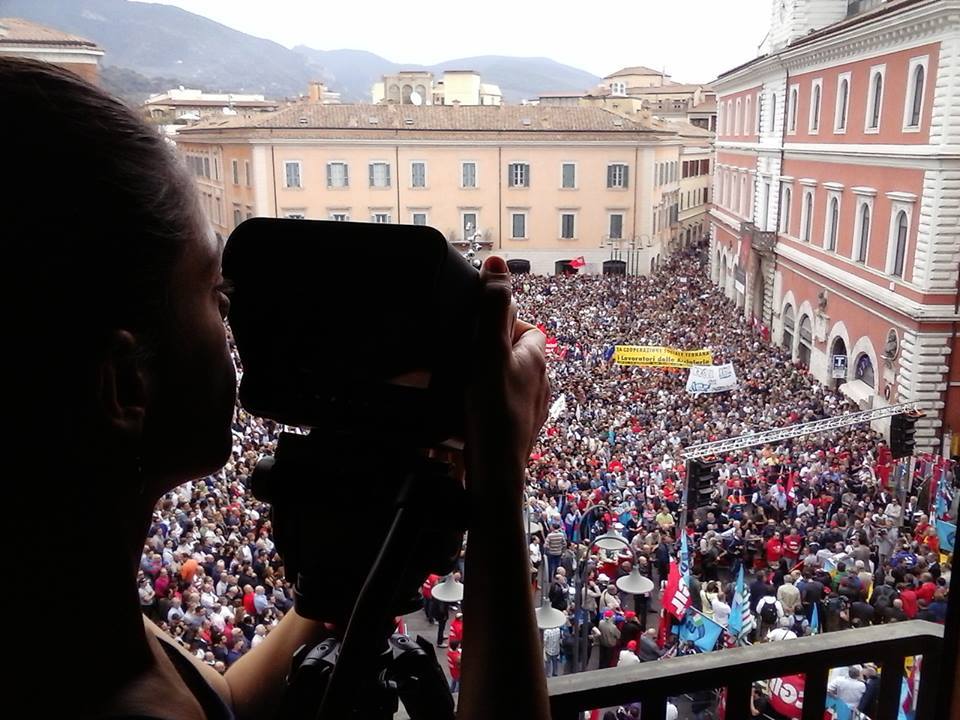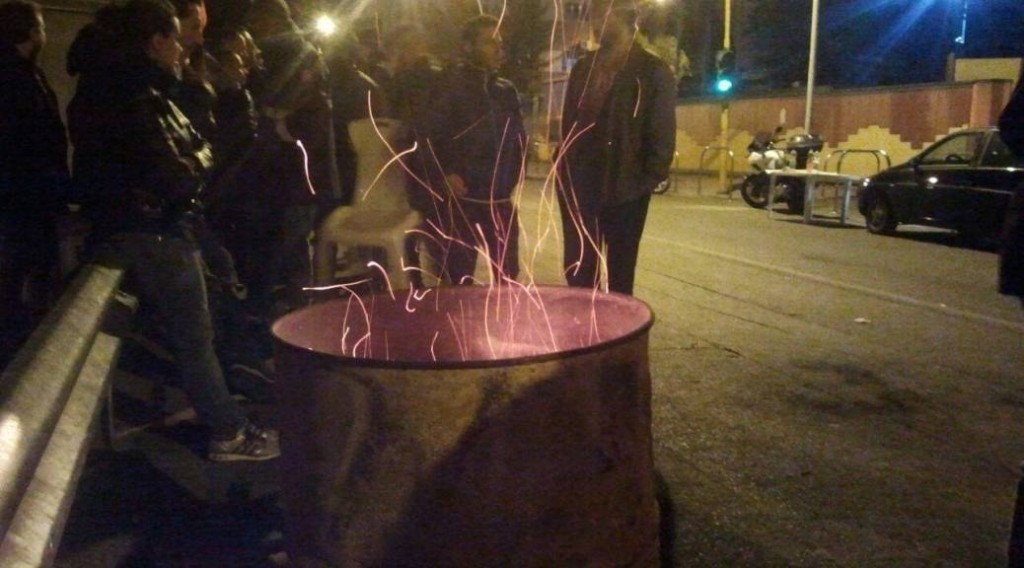My fieldwork began with an image, a quite common image of violence broadcast by Italian television: Terni steel plant (known as AST) workers were protesting by the station, pushing the police block in order to occupy the railways. Terni is a small town in the center of Italy, and every time a strike occurs, the workers always outnumber the local police force, and a SWAT squad is called from nearby Rome to control and sedate the rallies. This is how a Roman police officer managed to club the mayor of Terni, who had rushed to the station to mediate and ease the situation, confusing him with a worker/rioter. The image of the bleeding mayor jumped from local televisions to national channels in a matter of minutes, and this episode became the symbol of a struggle, and considerably helped the re-election of Leopoldo di Girolamo. It was May 2012, and ThyssenKrupp (TK), the German owner of AST, had sold the plant to Outokumpu, another steel multinational from Finland. Almost seven months after the buyout, Outokumpu didn’t present any strategic business plan, only the promise of investment in situ, which never happened. The exasperated workers, tired of promises and feeling fooled once again by a multinational, invaded the streets and shouted slogans that sometimes belonged more on the football pitch than in a political rally, testifying how the stadium behavior spilled into working-class protest, as Portelli (2010: 8) noticed during the 2004 general strike. Violence erupted at the first contact with the police officers, who certainly weren’t there to talk.
My fieldwork began with the image of a bleeding mayor accusing the police of being too violent—and the police publicly denying any responsibility by accusing a worker and his umbrella—because the minute I saw that short video on TV, I decided to go to Terni. In that image I could spot what Beller saw in Warhol’s Campbell’s Soup can: an icon of reification (2002: 76), a condensation of labor, class struggle, political and economic tension. Since a complex political economic situation can sometimes be better read through images, I decided to look at the changing identity of the local working class by making a shared documentary involving local filmmakers and workers.
Fig. 2: Leopoldo di Girolamo bleeding at the Terni steel plant protest of May 2012
Events followed that protest in May 2012, and the precarious situation dropped in February 2014, when ThyssenKrupp bought back the factory after the antitrust European law imposed upon Outokumpu forced it to sell. In July 2014, TK, through its new CEO Lucia Morselli, declared that it would pursue neither any industrial plan nor further investment. On the contrary, it now aimed to close one of the two furnaces (the core of any steel plant) and dismiss 550 workers, the worst series of cuts since the 1950s. After three months of unsuccessful negotiation between TK, unions, and the government, on 17 October 2014, the protest flowed into a general strike with 20,000 participants.
Ethnographic methodologies ask anthropologists to spend a prolonged amount of time with their subjects as participant observers, but the very idea of understanding the workers’ identity by working side by side with them in the steel plant, interviewing them outside of the gates, or sharing leisure time and meals with them has become more and more complex as the factory—in the sense of a whole of metal and flesh—was dragged into the disorienting dimension where capitalistic and anticapitalistic forces confront each other. To me, this new situation became a way to reflect on how to represent labor through images. The interviews I carried out in the relatively peaceful time before 17 July were barely memories of dismantled political identities belonging to a near past: no more ideologies, complete detachment of younger generations from working-class thematic, anxiety for the future, and the feeling of being powerless against the hegemonic Europe and powerful multinationals. Therefore, a literary transposition of these interviews into images of the workers’ lives and livelihoods would have been an intimate but limited portrayal of this community, expressed through one or a few well-chosen characters stylized by the director who, speaking for a group, represents a self-identity forged or bent by the factory labor. A film too much focused on the subjects’ emotions is detrimental to the actual understanding of complex contexts; the best-case scenario is a film showing reified contraposition between blue and any other color collars, as in ThyssenKrupp Blues (2008), a documentary about a fatal accident at the TK steel plant in 2007.
My first encounter with a local crew of filmmakers happened when I saw an advert in an online newspaper for a work-in-progress documentary with these exact premises, but despite my preconceptions, this work had an insight view and triggered so many interesting questions that I asked to be involved in the last part of its filming. Lotta senza classe (2014)—A Classless Struggle—portrays the lives of a trumpet player who works in the cold department, a union representative, and an immigrant working at AST for a subcontracted company. When I saw the final cut, I realized that this film could be the starting point for another documentary. With the dispute on the verge of erupting, I asked the crew to help me film a visual ethnography more focused on the events that were about to occur, with the goal of building a visual representation of the workers as a unity, as a political and subjective group.
One of my interviewees, a left-wing union representative, pointed out, “Today, the working class is a beautiful word.” This sentence embodies the crisis in political consciousness of the working class of Terni, its loss as subjective and self-defined entity, and its state of indeterminacy and fluidity. The condition of the working class in Terni today is characterized by indeterminateness, in opposition to the determinateness of the bourgeoisie. But perhaps the more the working class becomes aware of itself and elaborates its own cultural tools, the more the bourgeoisie loses its certainties, as both classes are determined by the presence of “the other.” It is precisely during a time of great struggle, when global capital is threatening local labor, that the workers alienate themselves from the never-ending, never-happening process of middle classification (Edwards et al. 2012) and look deeply into the failure of the universal aspirations to middle-class status.
During my fieldwork, I could record how the more the working class determines itself—the more it shows itself and becomes recognizable—the more fragmented its natural enemy turns out to be (the TK CEO, the Italian government, German-centric Europe, globalization, etc.). Also, this working-class process of determinateness progressively excludes others “like them,” that is, those who are not “traditional” blue collars. For instance, the AST workers often ask for participation in their cause by the socioeconomic town community as a whole, using slogans such as “If we close down, you close down.” However, they make resistance or even prevent precarious workers—those self-defined second- or third-class workers, or third-sector workers facing similar struggles—from speaking in public arenas when the present dispute about the steel plant is discussed. It seems they are asking for the town community’s presence, not its say. The AST workers’ class identity, with its demands and contradictions, may appear to an external observer as a multitude that becomes one for a short amount of time, like a shoal of fish pretending to be a big predator only when afraid of being eaten. This phenomenon must be analyzed as long as we are able to see it as internal and external observers.
Biografie di lotta (Biographies of Struggle), the documentary we are filming now, acts as a trigger and recipient, developed outside the factory, now a non-place where workers merge into that “multiplicity in movement” (Lazzarato 2013: 9) composed by precarious subcontracted workers, cultural workers, and AST workers’ relatives, which can’t be directly controlled by the factory disciplines.
This project aims to be a democratic space that speaks for the labor, exposing the violence of class relation, class struggle, and the dialectical relation between global capitalistic forces and local work. It intends to create a virtual platform to investigate and question the notions of production, labor, perception of local history, identity, and sense of place. Its agency (Gell 1998) is taking place on a mutual basis, in a mutual “language” shaped by the agent (filmmaker/researcher) and recipients (social actors and general spectators). This participatory project, between art and documentation, aims to channel art’s symbolic capital toward constructive social change—to recast artwork from a finite and portable product to an ongoing or long-term project. It aims to construct the audience not as a “viewer” or “beholder” but as a co-producer or participant (Bishop 2012: 1–11). To this purpose, Biografie di lotta cooperates with “Io sto con AST,” a blog on the dispute built by a worker. It also has a Facebook page and a website (under construction) built by an AST worker, where everyone actively involved in the protest will be able to upload their own videos recorded during public events such as strikes, pickets, assemblies, private moments, and the like, helping the visual ethnography “to happen” as a situation in its production.
In Beller’s cinematic mode of production, cinema and its derivatives are factories in which spectators work: to look is to labor, and workers and spectators, embedded in this structure, merge into the same exploited social actor (Beller 2006). Cinema integrates the logic of Taylorist production and conveyor belt, extending the factory to wherever it travels, but the cinematic type of production is much more intense than the industrial one: here the senses are drafted into production; the media capitalizes upon the aesthetic faculties and imaginary practices of viewers (Steyerl 2009). In this light, cinema parallels Gramsci’s dimension of capitalistic persuasion, challenging the logic of production, circulation, and accumulation. Ford created his own motion picture company, and last month Lucia Morselli bought the movie rights to Sette de denari (Pavanelli 2014), a book written by a BERCO worker about the struggle his factory went through last year, when Morselli was the CEO: similar to the Terni scenario and the same policy of redundancies. The hatchet woman-turned-film-producer has undoubtedly opened up a new frontier of surplus value extraction, but the question is, how can this film represent the factory or the workers’ struggle?
Roberts (2012) points out that the bourgeois culture cannot incorporate its proletarian critique in its own symbolic reproduction, and even if capital is able to expose the violence of class relations as part of its reproduction, it cannot speak for labor. He adds that the representation of the factory begins when the production of value is interrupted; during its dismantling process, the factory doesn’t wait to be represented but dismantled. This could happen through a process of fragmentation and deterritorialization that beings, especially during strikes, just outside the gate in the factory forecourt; the workers overstep the boundary of the protected production sphere and stream the public space, where they are joined by other classes “to transform an economic struggle into a political one” (Farocki 2002). Today this allows the multitude of exploited social actors to produce their own images of symbolic reproduction, recorded with their own cameras often embedded in devices such as smartphones. Following Kücklich’s definition of Taylorization of leisure these e-eyes objects symbols of capitalistic hegemonic persuasion deterritorialize the factory (2005), building the new axiom to look is to “playbor.” These e-eyes could be the right tool to record the shoal of fish, the “multiplicity in movement” taking advantage of these fragmented and deterritorialized “glances” to put together a composite working-class image, like Farocki’s Videograms of a Revolution (1992).
Matteo Saltalippi is a PhD candidate in visual anthropology at Goldsmiths University of London with a BA in social anthropology and an MA in visual anthropology. He has been involved in documentary production since his BA.
References
Beller, Jonathan. 2006. The cinematic mode of production: Attention economy and the society of the spectacle. Hanover, N.H.: Dartmouth College Press.
Beller, Jonathan. 2002. Kino-I, Kino World: Notes on the cinematic mode of production. In Nicholas Mirzoeff, ed., The visual culture reader, pp. 60–86. London and New York: Routledge.
Bishop, Claire. 2012. Artificial hells: Participatory art and the politics of spectatorship. London and New York: Verso.
Edwards, Jeanette, Gillian Evans, and Katherine Smith. 2012. Introduction: The middle class-ification of Britain. Focaal – Journal of Global and Historical Anthropology 62: 3–16, doi:10.3167/fcl.2012.620101.
Farocki, Harun. 2002. Workers leaving the factory. Senses of Cinema 21.
Gell, Alfred. 1998. Art and agency: An anthropological theory. New York: Oxford University Press.
Gramsci, Antonio. 1978. Quaderno 22: Americanismo e fordismo. Torino: Piccola Biblioteca Einaudi.
Kücklich, Julian. 2005. Precarious playbour: Modders and the digital games industry. The Fibreculture Journal 21.
Lazzarato, Maurizio. 2013. Il governo delle disuguaglianze: Critica dell’insicurezza neoliberista. Verona: Ombre Corte.
Pavanelli, Simone. 2014. Sette di denari: Una moderna lotta d’altri tempi. Latina: DrawUp.
Portelli, Alessandro. 2004. Memory and globalization in the Terni general strike of 2004. History, Anthropology and Oral Sources 32: 49–60.
Roberts, John. 2012. The missing factory. Mute (accessed 9 February 2013).
Steyrel, Hito. 2009. Is a museum a factory? E-Flux 7 (accessed 5 April 2013).
Filmography
Lotta senza classe. 2014. Directed by Greca Campus. Terni, Italy: Associazione Culturale Thamus.
ThyssenKrupp blues. 2008. DVD. Directed by Pietro Balla and Monica Repetto. Rome, Italy: Deriva Film, BabyDoc Film, Esperia Film.
Videograms of a revolution. [1992] 2006. DVD. Directed by Andrei Ujica and Harun Farocki. Chicago: Facets.
Discover more from FocaalBlog
Subscribe to get the latest posts sent to your email.



